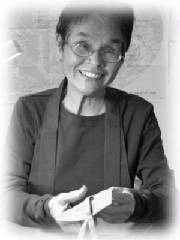Hi Folks,
At the beginning of Tomoe Katagiri's writings on Rakusu's she gives the measurements for sewing in inches (which she uses throughout), CM and the traditional Japanese measure Bu. There are 10 Bu in a Shu, and 10 Shu in a Shaku. A Bu is 3.030 mm. The measurements in CM are quite different than those given in Inches when you convert. And I could never make any sense of the Bu measures because it seemed to indicate a Rakusu that was about 8 inches wide. It doesn't help that there is a typo on the page. So I kind of gave up looking into that.
It doesn't help that there is a typo on the page. So I kind of gave up looking into that.
Also, in a related note, her Rakusu differs from ours in design. It is harder to find examples on line but this is what her's tend to look like
katagiri style.jpg
Note the much larger gap between Yos. And it is funny to me that SFZC teaches Rakusu sewing that matches our design. And yet Tomoe Katagiri started the sewing there. Which makes me wonder when it changed.
Anyway, I was searching the web for information about Nyoho-e and somehow came across a thread where Jundo gave a link to a Japanese site that had instructions on how to sew a Rakusu (in Japanese).
And in this link they give the measurements in what look like Sun. And because their design also looked like the one that Tomoe uses I matched them up and their measurement and layout match her's perfectly.
So I translated the page with Google trying to learn more about their measurements and it was translated as "Whale Scale". I figured that had to be some weird translation error but I got searching. I finally found a reference in an old military text from the 1940s of all places - eventually confirmed by Wikipedia.
It turns out that Tailors in Japan used their own measurement variant. Don't know why. The also used Bu, Sun, and Shaku. But for the Tailors a Sun = 1.25 times a standard Sun (and so on for the other measures).
And in them olden days the rulers that Tailors used were made from Baleen. Yes, whale. And so it is called the Whale scale.
Also in my searching I found this great interview with Tomoe
And in it she says that Katagiri Roshi was the one that advocated using Nyoho-e, he had used it in Japan, and he convinced Shunryu Suzuki to adopt the approach and have students start sewing their own Rakusu. I never knew that connection before.
So I figured there might be a picture of him wearing the Tomoe style Rakusu and so I searched. I found two pictures, here is one.
wb-dk.78.jpg
Yup, that is our style not the one Tomoe taught.
Someday I would like to know the story behind these two designs.
Oh, and I also ran across this t shirt for sale in Japan.
essay_know_14004_03.jpg

Also in the book there were references to Japanese measures of Area called Tan and Cho. With Cho being larger than Tan. I wonder if that is where the names come from. Areas of the "rice field".
Gassho, Shinshi
SaT-LaH
At the beginning of Tomoe Katagiri's writings on Rakusu's she gives the measurements for sewing in inches (which she uses throughout), CM and the traditional Japanese measure Bu. There are 10 Bu in a Shu, and 10 Shu in a Shaku. A Bu is 3.030 mm. The measurements in CM are quite different than those given in Inches when you convert. And I could never make any sense of the Bu measures because it seemed to indicate a Rakusu that was about 8 inches wide.
 It doesn't help that there is a typo on the page. So I kind of gave up looking into that.
It doesn't help that there is a typo on the page. So I kind of gave up looking into that.Also, in a related note, her Rakusu differs from ours in design. It is harder to find examples on line but this is what her's tend to look like
katagiri style.jpg
Note the much larger gap between Yos. And it is funny to me that SFZC teaches Rakusu sewing that matches our design. And yet Tomoe Katagiri started the sewing there. Which makes me wonder when it changed.
Anyway, I was searching the web for information about Nyoho-e and somehow came across a thread where Jundo gave a link to a Japanese site that had instructions on how to sew a Rakusu (in Japanese).
And in this link they give the measurements in what look like Sun. And because their design also looked like the one that Tomoe uses I matched them up and their measurement and layout match her's perfectly.
So I translated the page with Google trying to learn more about their measurements and it was translated as "Whale Scale". I figured that had to be some weird translation error but I got searching. I finally found a reference in an old military text from the 1940s of all places - eventually confirmed by Wikipedia.
It turns out that Tailors in Japan used their own measurement variant. Don't know why. The also used Bu, Sun, and Shaku. But for the Tailors a Sun = 1.25 times a standard Sun (and so on for the other measures).
And in them olden days the rulers that Tailors used were made from Baleen. Yes, whale. And so it is called the Whale scale.
Also in my searching I found this great interview with Tomoe
And in it she says that Katagiri Roshi was the one that advocated using Nyoho-e, he had used it in Japan, and he convinced Shunryu Suzuki to adopt the approach and have students start sewing their own Rakusu. I never knew that connection before.
So I figured there might be a picture of him wearing the Tomoe style Rakusu and so I searched. I found two pictures, here is one.
wb-dk.78.jpg
Yup, that is our style not the one Tomoe taught.
Someday I would like to know the story behind these two designs.
Oh, and I also ran across this t shirt for sale in Japan.
essay_know_14004_03.jpg

Also in the book there were references to Japanese measures of Area called Tan and Cho. With Cho being larger than Tan. I wonder if that is where the names come from. Areas of the "rice field".
Gassho, Shinshi
SaT-LaH






Comment